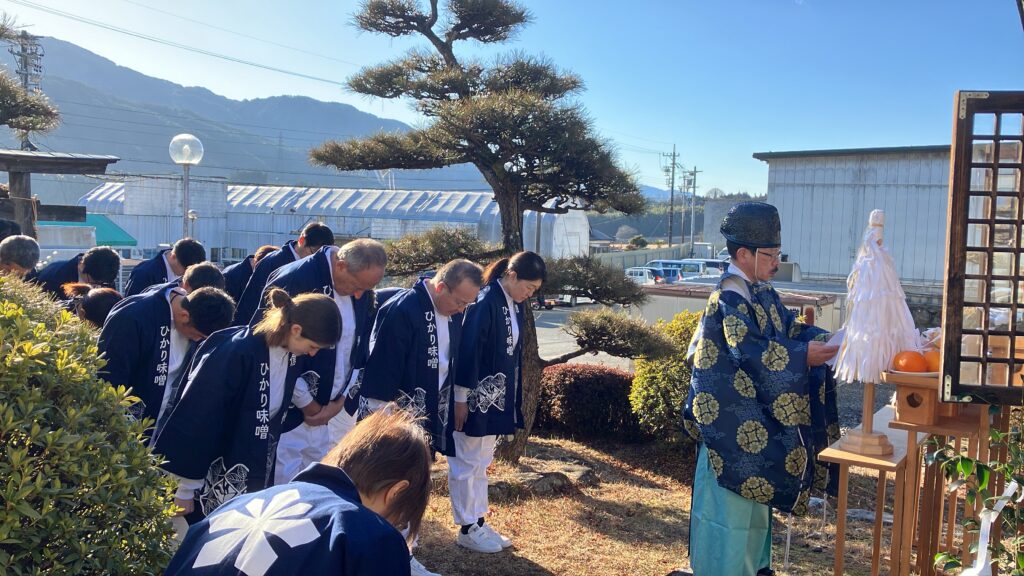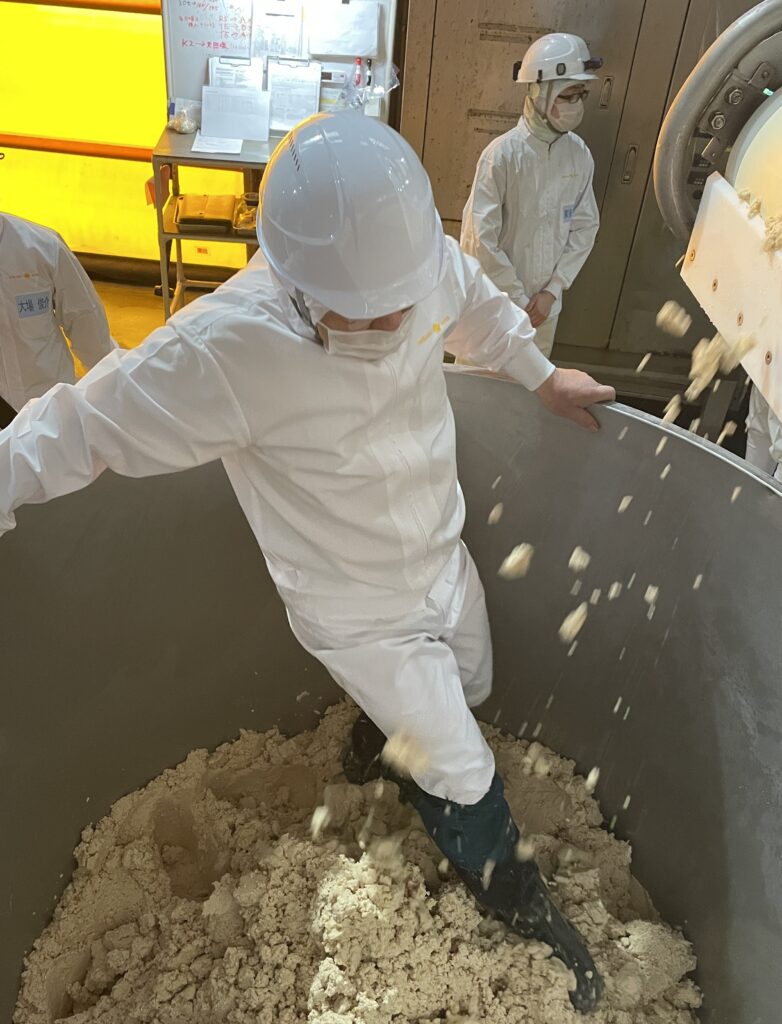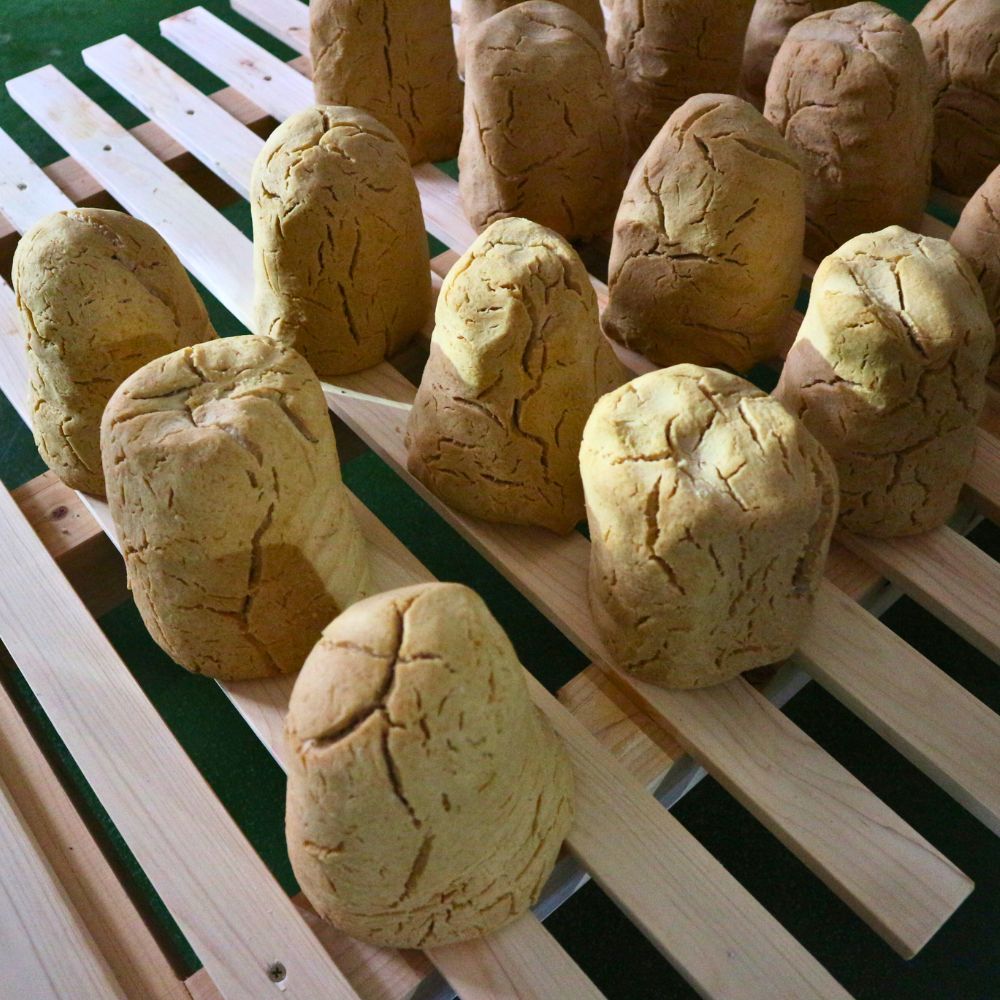TRADITIONAL MISO-MAKING TECHNIQUES PRESERVED AND PROMOTED AT ANNUAL “DAIKANJIKOMI” RITUAL
Posted on February 12, 2025
On January 31, 2025, Hikari Miso Co., Ltd. carried out its annual “Daikanjikomi” miso production using traditional techniques at its Iijima Green factory in Nagano Prefecture. This marks the 40th Daikanjikomi event since Hikari Miso first undertook this time-honored ritual in 1985. Daikanjikomi is of great significance to the company as a way to express gratitude for the ability to engage in miso production, preserve and promote the miso-making philosophy of previous generations, and ensure that the essence of Hikari Miso craftsmanship is maintained. It also allows employees to refresh their commitment to the fundamentals of miso production. This year, miso-making staff were joined by those from other divisions, demonstrating and passing on their skills. We were also delighted to welcome guests from one of our British partners. We took the opportunity to demonstrate to them, through traditional techniques and processes, our earnest commitment to high-quality miso production.

Prayers for a productive year of miso-making, safe factory operations, and tasty miso
■ ”DAIKANJIKOMI” AT HIKARI MISO
The term “Daikanjikomi” refers to the use of new rice and soybeans from the previous autumn’s harvest and traditional techniques to make miso during the period of Daikan, one of the 24 seasonal divisions of the ancient calendar. This extremely cold time of year is deemed the most suitable for miso production due to the relative lack of bacteria in the air. This year’s Daikanjikomi was performed using “Yukihomare” soybeans from Hokkaido, rice koji from Niigata “Koshihikari” rice, and “Umi wa inochi” salt from Nagasaki.
Daikanjikomi at Hikari Miso commences at a small Shinto shrine on the Iijima Green site originating from Matsunoo Taisha, a Kyoto shrine dedicated to the god of fermentation. Prayers are offered for a productive year of miso-making, safe factory operations, and tasty miso. Next, miso balls (misodama) prepared earlier are crushed and added to steamed soybeans. This mix is blended with rice koji and salt and poured into a 2-tonne tank. At this point, the miso is treaded by foot in the tank to remove any air and ensure that fermentation/aging progresses uniformly. The miso balls, made by mashing steamed Japanese soybeans and molding them by hand while still warm into cylinders about 20cm high, give Daikanjikomi miso enhanced flavor depth, thanks to a slow lactic acid fermentation that takes place over several days before their addition to the mix.
In conventional commercial miso production, the mix is heated to a suitable temperature to encourage fermentation by creating favorable conditions for microorganism activity. Daikanjikomi miso, however, is produced by slow natural fermentation, with no human interference. When the outside temperature grows warmer, the miso is turned into the tank, exposing microorganisms in the miso to air to promote fermentation. This means that the speed of fermentation/aging varies according to the temperature and climatic conditions, resulting in a different flavor for each year’s batch.


Miso Tread and Misodama (miso balls)
At this year’s Daikanjikomi, Hikari Miso employees involved in miso-making were joined by staff from other parts of the operation to revisit the fundamentals of miso craftsmanship, with each section passing on its specialist skills. Our British guests also had the chance to experience Hikari Miso Daikanjikomi rituals and techniques preserved continuously for generations.
■ Comments from participants
From our British partner
Today’s incredible miso ceremony is like nothing we have ever seen. We felt honored and humbled to be a part of it and are so grateful to Mr. Hayashi, Shoki, and Eriko, members of the International Sales Division, for their hospitality. To visit this amazing miso factory nestled in the beautiful mountains of Nagano and pray to the fermentation gods with all the kind and talented Hikari employees is a once-in-a-lifetime opportunity. We also feel proud to stomp the miso with you to begin the natural fermentation process! We will never forget this.
From Hikari Miso staff member at Iijima Green factory, packing section
I learned that in the miso-making section, they do not just make miso but carefully take a number of steps to ensure uniform taste and quality. Having the opportunity to tread the miso personally offered an insight into how much is actually involved in miso-making and the profound nature of the process. I will continue playing my part to deliver to customers the miso so meticulously crafted in the miso-making section as an even better product.
From Hikari Miso staff at marketing section
Starting with the Shinto ritual, then the miso treading and packaging, this was a precious first-hand look at the history of Hikari Miso miso-making and its traditional techniques. As part of the marketing team, I will be making maximum use of this experience in my new product planning and marketing activities to spread the word about the value of the Daikanjikomi products Hikari Miso crafts with such pride, not only to Japanese customers but to people overseas as well.
■ “DAIKANJIKOMI” MISO FEATURES
Daikanjikomi miso is a very special miso crafted from the finest high-quality ingredients, carefully blended and fermented. Aging slowly at a low temperature during natural fermentation results in a miso of solid umami and deep, not overly salty flavor that suffuses the palate with a distinctive tang plus hints of sweetness and astringency. Daikanjikomi miso’s longer fermentation also gives it a more mature aroma. Long-aged miso is manually blended with exquisite attention to detail by experienced miso-makers to avoid crushing the koji grains, then packed individually by hand to preserve the koji’s sweetness and flavor depth.
Media Contact
HIKARI MISO Co., Ltd. Public Relations
info@hikarimiso.co.jp
